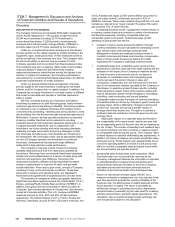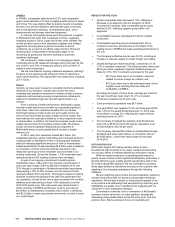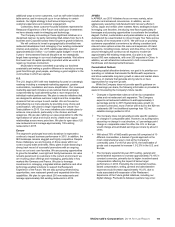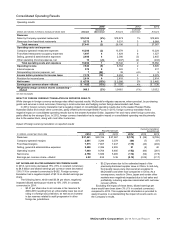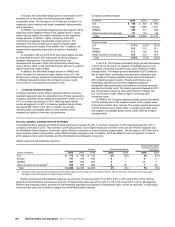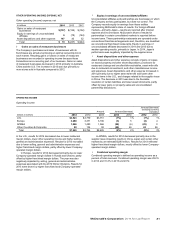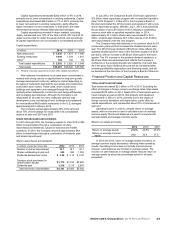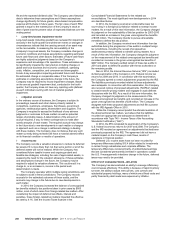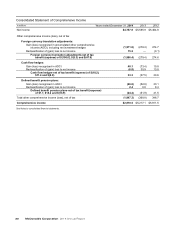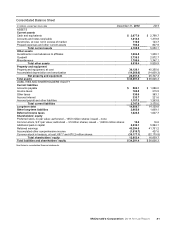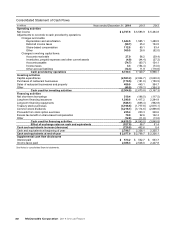McDonalds 2014 Annual Report Download - page 28
Download and view the complete annual report
Please find page 28 of the 2014 McDonalds annual report below. You can navigate through the pages in the report by either clicking on the pages listed below, or by using the keyword search tool below to find specific information within the annual report.
22 McDonald’s Corporation 2014 Annual Report
INTEREST EXPENSE
Interest expense increased 9% and 1% in 2014 and 2013,
respectively, primarily due to higher average debt balances. In
addition, interest expense in 2013 benefited from lower average
interest rates.
NONOPERATING (INCOME) EXPENSE, NET
Nonoperating (income) expense, net
In millions 2014 2013 2012
Interest income $(20) $(15) $ (28)
Foreign currency and hedging activity 20 8 9
Other expense 745 28
Total $ 7 $ 38 $ 9
Interest income consists primarily of interest earned on short-term
cash investments. Foreign currency and hedging activity includes
net gains or losses on certain hedges that reduce the exposure to
variability on certain intercompany foreign currency cash flow
streams.
PROVISION FOR INCOME TAXES
In 2014, 2013 and 2012, the reported effective income tax rates
were 35.5%, 31.9% and 32.4%, respectively.
In 2014, the higher effective income tax rate was primarily due
to a change in tax reserves for 2003-2010 resulting from an
unfavorable lower tax court ruling in a foreign tax jurisdiction, as
well as the impact of changes in tax reserves related to audit
progression in multiple foreign tax jurisdictions. Excluding these
items, the effective income tax rate would have been 31.4%.
In 2013, the effective income tax rate included a tax benefit of
nearly $50 million, reflecting the retroactive impact of certain tax
benefits as a result of the American Taxpayer Relief Act of 2012.
In 2012, the effective income tax rate reflected the negative
impact of certain tax benefits in the U.S. that had expired at
December 31, 2011 and were reinstated retroactively in 2013 as
noted above.
Consolidated net deferred tax liabilities included tax assets,
net of valuation allowance, of $1.6 billion in 2014 and $1.5 billion
in 2013. Substantially all of the net tax assets are expected to be
realized in the U.S. and other profitable markets.
RECENTLY ISSUED ACCOUNTING STANDARD
In May 2014, the Financial Accounting Standards Board issued
guidance codified in Accounting Standards Codification ("ASC")
606, "Revenue Recognition - Revenue from Contracts with
Customers," which amends the guidance in ASC 605, "Revenue
Recognition," and becomes effective beginning January 1, 2017.
The Company is currently evaluating the impact of the provisions
of ASC 606.
Cash Flows
The Company generates significant cash from its operations and
has substantial credit availability and capacity to fund operating
and discretionary spending such as capital expenditures, debt
repayments, dividends and share repurchases.
Cash provided by operations totaled $6.7 billion and
exceeded capital expenditures by $4.1 billion in 2014, while cash
provided by operations totaled $7.1 billion and exceeded capital
expenditures by $4.3 billion in 2013. In 2014, cash provided by
operations decreased $390 million or 5% compared with 2013
primarily due to lower operating results, partly offset by lower
income tax payments. In 2013, cash provided by operations
increased $155 million or 2% compared with 2012 primarily due to
increased operating results.
Cash used for investing activities totaled $2.3 billion in 2014,
a decrease of $369 million compared with 2013. The decrease
primarily reflected lower capital expenditures, a decrease in other
investing activities related to short-term time deposits and higher
proceeds from sales of restaurant businesses. Cash used for
investing activities totaled $2.7 billion in 2013, a decrease of $493
million compared with 2012. The decrease primarily reflected
lower capital expenditures and a decrease in other investing
activities related to short-term time deposits.
Cash used for financing activities totaled $4.6 billion in 2014,
an increase of $575 million compared with 2013, primarily due to
higher treasury stock purchases, partly offset by an increase in net
borrowings. Cash used for financing activities totaled $4.0 billion in
2013, an increase of $193 million compared with 2012, primarily
due to lower net debt issuances and higher dividend payments,
partly offset by lower treasury stock purchases.
The Company’s cash and equivalents balance was $2.1
billion and $2.8 billion at year end 2014 and 2013, respectively. In
addition to cash and equivalents on hand and cash provided by
operations, the Company can meet short-term funding needs
through its continued access to commercial paper borrowings and
line of credit agreements.
RESTAURANT DEVELOPMENT AND CAPITAL EXPENDITURES
In 2014, the Company opened 1,298 traditional restaurants and 18
satellite restaurants (small, limited-menu restaurants for which the
land and building are generally leased), and closed 317 traditional
restaurants and 170 satellite restaurants. In 2013, the Company
opened 1,393 traditional restaurants and 45 satellite restaurants
and closed 295 traditional restaurants and 194 satellite
restaurants. The majority of restaurant openings and closings
occurred in the major markets in both years. The Company closes
restaurants for a variety of reasons, such as existing sales and
profit performance or loss of real estate tenure.
Systemwide restaurants at year end(1)
2014 2013 2012
U.S. 14,350 14,278 14,157
Europe 7,855 7,602 7,368
APMEA 10,345 9,918 9,454
Other Countries & Corporate 3,708 3,631 3,501
Total 36,258 35,429 34,480
(1) Includes satellite units at December 31, 2014, 2013 and 2012, as follows:
U.S.—919, 973, 997; Europe—273, 261, 246; APMEA (primarily Japan)—
641, 733, 871; Other Countries & Corporate—433, 451, 453.
Approximately 70% of Company-operated restaurants and
nearly 75% of franchised restaurants were located in the major
markets at the end of 2014. Over 80% of the restaurants at year-
end 2014 were franchised.


